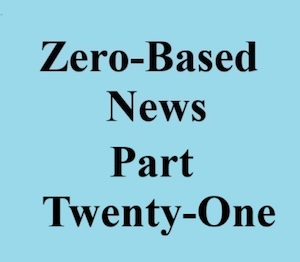Peirspictiochtai Ar An Saol
Zero-Based News
Part Twenty-One

In Zero-Based News, the news that forms the base of information for audiences – whether readers, listeners, or viewers – follows specific aspects of philosophy and standards. Each news piece published – whether by broadcast, print, or digital means – should follow the key aspects of the Philosophy and Standards of Zero-Based News, including:
Accuracy:
Be accurate with facts.
If possible, gather information from original sources.
If possible, confirm facts through two independent sources.
When appropriate and feasible, identify sources of information.
Avoid using anonymous sources except in specific cases where identification of a specific source would endanger either that source or others.
When quoting opinions, thoughts, or feelings of individuals, identify those items as the personal opinions, thoughts, or feelings of the quoted individuals.
Assumptions:
Avoid assumptions about what appear to be "obvious" facts.
Attributions:
Where attribution is requested or appropriate, credit each source of text, images, photographs, illustrations, maps, graphs, audio, video, and/or other elements by listing the specific source either with the specific element or at the conclusion of the news piece. In each case, where possible, include the name of the source and the date when the element was created. Elements in the public domain should be listed as such and attribution provided if specific details are available.
When quoting text from other sources, identify the sources within the body of a news piece and utilize quotation marks.
If information is being quoted or paraphrased from another news source, highlight the name of the specific news source in italics within the body of the news piece.
Off-the-record requests should be declined unless no other options appear to be feasible to secure needed information. In a rare situation when considering an off-the-record request, do not agree to such a request unless acceptable. Do not allow sources to assume that their statements are off-the-record when that is not the case. If a specific off-the-record request is acceptable and granted, honor your commitment. If you later determine that you need a specific statement on the record that you had agreed would be off the record, request permission from the specific source. If the specific source declines, honor the off-the-record commitment.
Clarifications:
If, after publication, further clarification is determined to be appropriate, update the news piece or add a note of clarification to the news piece.
Context:
A news piece should place facts in context.
Fairness:
Provide an opportunity for subjects of a news piece to present their views.
Present, as much as possible, all reasonable sides to an issue. That may be both sides of an issue or it could be 17 sides of an issue. It is not necessary or appropriate to present viewpoints that advocate hatred, violence, or related emotions and actions.
Format:
Include, when appropriate and feasible, text, images, photographs, illustrations, maps, graphs, audio, video, and/or other elements.
On occasion, where appropriate and feasible, include links within a news piece to third-party sites for further information.
Investigative:
An investigative news piece may focus on negative aspects of a situation, but need not do so. This type of news piece may, instead, focus on potential solutions to problems identified in the news piece.
Localization:
A news piece should include information that would be of interest to its specific audience. Elements in a news piece should be as local as possible for the target audience. In this context, "local" can mean geographically local as well as local to a specific subject matter.
Beyond local elements, additional information that is community-wide, regional, national, or international in scope may be added to a news piece to provide context.
Mistakes:
Correct typographical and grammatical errors as soon as possible.
Correct factual errors as soon as possible.
Major corrections should be noted, as needed.
Publication:
A news piece should be published only once all of the information included has been verified for accuracy and fairness.
A news piece should not be published just to be first to market.
Social Media:
Utilize social media, when appropriate and feasible, to gather and confirm information unavailable through other means.
Encourage traffic to the main news piece through the use of social media.
Sponsorships:
If a specific news piece is sponsored by a specific entity, that sponsorship is to be noted with that news piece.
News pieces that are sponsored are to be fact-based and journalistically sound.
Sponsors have no editorial control over content, and sponsors do not preview the news pieces before publication.
Content in each news piece may include information from sponsors as well as content from others not related to the sponsors.
Comments from sponsors and other parties are to be placed in quotations to provide transparency in the news pieces.
Timing:
If possible, tie a news piece to a specific date and time that has bearing on that news piece itself – an anniversary, a holiday, an event, or similar activity.
The next news column in this series will focus on how Zero-Based News would provide the information needed by its readers, viewers, and listeners.
Peirspictiochtai Ar A Saol – Gaelic – Irish – for "Perspectives On Life" is a column focused on aspects of accountability and responsibility as well as ways people look at life.
Contact Richard McDonough at
© 2025 Richard McDonough









